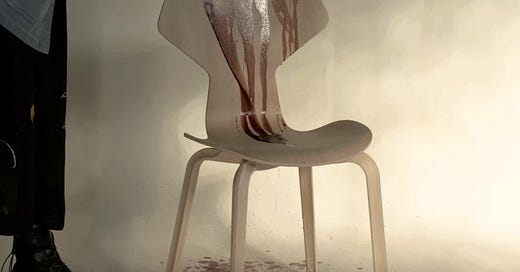When Natural Wine Meets Mid-Century Design
Gut Oggau and Fritz Hansen made chairs. Is this the new mixed agriculture?

Austria announced a twenty-day lockdown two Fridays ago to combat a resurgent wave of COVID, which meant the cancellation of this year’s highly-anticipated Karakterre natural wine salon. At least one Burgenland natural wine-related project is moving forward, however: the Saturday after lockdown was announced, Eduard and Stephanie Tscheppe of Gut Oggau released a video on Instagram announcing a new collaboration with Danish furniture design company Fritz Hansen, notable for producing the iconic designs of Arne Jacobsen.
The minute-and-fifteen-second video depicts the Tscheppes standing at sunset on a bluff overlooking the flatland of Burgenland, amid a cluster of wooden chairs. Cut to the couple and the chairs amid their autumnal vines. Now a Gut Oggau label sporting a drawing of a chair is applied to a bottle and numbered. The bottle of red wine is duly uncorked by male hands (Eduard’s) then emptied, with some ceremony, over one of the chairs, beginning with the seat. Stephanie Tscheppe pours wine over another chair, beginning with the back. What looks like a giant matchstick, but which is in fact a chair leg, is then dipped into wax, the finishing touch.
Collaborations between wineries and design firms (be it furniture, architecture, or fashion) have until now been mostly limited to the mass-lux sectors of Champagne and Bordeaux. For example, Philippe Starck and the cellar he designed in 2016 for Les Carmes Haut-Briton. I recall having a good laugh when designers Viktor & Rolf collaborated with Piper-Heidsieck on ludicrous Champagne glasses.
But the worlds of (better) design and actual good natural wine have been arcing into ever-closer orbit for a while. Recall the hubbub in 2011 when Paris chef Inaki Aizpitarte unveiled his marble-paned natural wine bar Le Dauphin, designed by Rem Koolhaas and Clement Blanchet. More recently, the natural wine distributor Culinaries opened a location of their YARD natural wine bar in a Galeries Lafayette on the Champs-Elysées. When I visited before the pandemic, I saw bottles from Fred Cossard and Renaud Guettier stocked beside Veuve Clicquot and little plastic bags of pink calissons.
Earlier generations of natural vignerons, conversely, have tended to avoid associating their work with high-end design, or any kind of luxury whatsoever, whether out of instinctive mistrust, or a particularly French concern about getting beheaded in a future revolution. Within France especially, certain perceptibly wealthy and cosmopolitan natural vignerons go to great lengths to remain paysan in public. (Unshowy footwear; standing near saucisson at all times, etc.)
So what does it mean when an acclaimed Austrian natural wine estate collaborates with a chic Danish furniture design firm?
For what it’s worth, the Tscheppes are not profiting in any material way from the project, which is limited to 24 chairs and and 120 bottles of wine, none of which will be available for sale. The chairs and wine are being exhibited and tasted, respectively, at events at Fritz Hansen showrooms in Copenhagen, Seoul, Tokyo, and New York. Eduard Tscheppe, with characteristic crypticness, described the wine as “a vineyard blend of red grapes” when we spoke.
For the Tcheppes, the project was a joyful occasion to collaborate with friends in the film, music, and design industries. But watching natural vignerons employ their wine as a furniture stainer is jarring. I had a lot to think about after the one-minute, fifteen second video.
Is Gut Oggau x Fritz Hansen a symbolic betrayal of natural wine’s paysan origins? Or is it a harmless association born of a realistic recognition of the cost of natural winemaking, and the socioeconomic bracket of the real audience for such wine today?
Is Gut Oggau x Fritz Hansen mere dilettantism? Or is it healthy interdisciplinary outreach, the product of inquiring minds, shameful only if regarded through the warped lens of the misguided specialization that has marked 20th-century agriculture in general, and viticulture in particular?
I guess what I’m asking is: is dilettantism the new mixed agriculture ?
Before WWII, natural vignerons grew wheat and fruit and made cheese, in addition to making wine. It helped alleviate the commercial pressure to make too much wine, or to cheapen it in the winemaking process. Today’s natural vignerons make chairs with Danish design firms.
I’m also thinking of Ardèche vigneron-négoçiant Anders Frederik Steen, who’s releasing a book of his winemaking notes and musings in collaboration with interior design magazine Apartamento on Thursday. And of the swashbuckling natural wine pioneer Jean-Pierre Robinot, who promotes his abstract photography with as much fervor as his long-aged chenin and pineau d’aunis. And even of Beaujolais vigneron Romain des Grottes, who has begun moonlighting as an online life coach. (Really !) He says it pays relatively well, and he enjoys how it allows him a perspective into careers other than winemaking.
I’m sure there are a lot of other vignerons with things other than wine on their minds. More would probably speak up about their outside interests more often, if it weren’t for a certain abiding social pressure - not limited to the world of wine - to commit to specialization, at the risk of appearing unserious.
Anyway. I caught up with the Tscheppes over the phone the other day to chat about their new furniture collaboration, and what it represents for them. Subscribers can check out the interview here.
With Austria in mind, I also wrote about Styrian vigneron Franz Strohmeier’s thought-provoking experiments with minimal pruning, which, interestingly, put him on the frontlines of what you might call the un-invention of viticulture, alongside seemingly disparate French vignerons like Patrick Desplats and Romuald Valot.
That’s all for now. Take care out there, stay warm, and many thanks for reading, as always!
Was this essay interesting ? There’s more where that came from - along with exclusive natural wine interviews, reports, and profiles - for Not Drinking Poison subscribers.



Fantastic set of pieces here, Aaron.